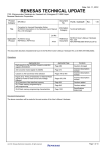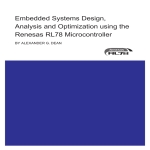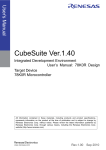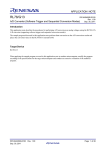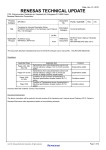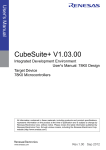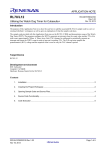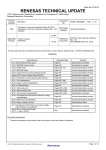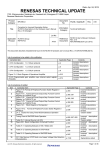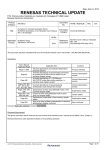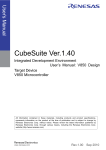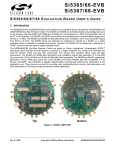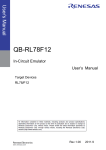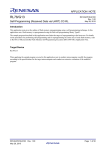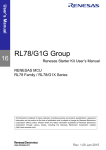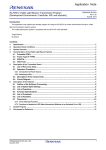Download RL78/G13 Basic Initialisation for Cubesuite+ and IAR Toolchain
Transcript
APPLICATION NOTE RL78/G13 Basic Initialisation for Cubesuite+ and IAR Toolchain R01AN1083EG0100 Rev.1.00 Mar 13, 2012 Introduction This application note describes the basic setting items that are necessary for initializing the RL78/G13. The sample program discussed in this application note initializes the RL78/G13 and provides on/off control of three LEDs according to the combination of two switch input states. Target Device RL78/G13 When applying the sample program covered in this application note to another microcomputer, modify the program according to the specifications for the target microcomputer and conduct an extensive evaluation of the modified program. This application note has been updated for the RSKRL78/G13 hardware platform. R01AN1083EG0100 Rev.1.00 Mar 13, 2012 Page 1 of 31 RL78/G13 Basic Initialisation for Cubesuite+ and IAR Toolchain Contents 1. Installation ......................................................................................................................................... 3 2. Specifications .................................................................................................................................... 3 3. Operation Check Conditions ............................................................................................................. 4 4. Description of the Hardware.............................................................................................................. 5 4.1 Hardware Configuration Example ..................................................................................................... 5 4.2 List of Pins to be Used ...................................................................................................................... 5 5. Description of the Software ............................................................................................................... 6 5.1 Operation Outline .............................................................................................................................. 6 5.2 List of Option Byte Settings............................................................................................................... 7 5.3 List of Functions ................................................................................................................................ 7 5.4 Function Specifications ..................................................................................................................... 8 5.5 Flowcharts ....................................................................................................................................... 10 5.5.1 Initialization Function.............................................................................................................. 17 5.5.2 System function...................................................................................................................... 18 5.5.3 Setting up the I/O Ports [TODO] ............................................................................................ 19 5.5.4 CPU Clock Setup ................................................................................................................... 23 5.5.5 Main Processing..................................................................................................................... 29 6. Sample Code................................................................................................................................... 30 7. Documents for Reference ............................................................................................................... 30 Website and Support ............................................................................................................................... 31 Revision Record ........................................................................................................................................ 1 General Precautions in the Handling of MPU/MCU Products ................................................................... 2 R01AN1083EG0100 Rev.1.00 Mar 13, 2012 Page 2 of 31 RL78/G13 1. Basic Initialisation for Cubesuite+ and IAR Toolchain Installation This application note and associated code has been written to work with both Cubesuite+ and IAR IDEs and compilers. Decompress (if zipped) the files. For Cubesuite+: Open the .mtpj project in the \CS+ Code directory in Cubesuite+ For IAR: Open the .eww workspace in the \IAR directory in IAR Workbench. 2. Specifications The sample program described in this application note performs basic initialization steps such as the setup of the clock frequency and input/output ports. After the initialization, the program controls, in its main processing routine, the on/off of three LEDs according to the combination of two switch input states. Table 2.1 lists the Peripheral Functions to be Used and their Uses and figure 2.1 shows the outline of the initialization processing. Table 2.1 Peripheral Functions to be Used and their Uses Peripheral Function Use Port input/output Switch input (SW1 and SW2) LED on/off control (LED1 to LED3) <Input> <Output> ON SW1 LED1 SW2 LED2 LED3 RL78/G13 LED Output Switch Input SW1 (P50) SW2 (P51) LED1 (P53) LED2 (P62) LED3 (P63) OFF OFF OFF OFF OFF ON OFF ON OFF OFF OFF ON OFF ON OFF ON ON OFF OFF ON Figure 2.1 Overview of LVD Operation (Reset Mode) R01AN1083EG0100 Rev.1.00 Mar 13, 2012 Page 3 of 31 RL78/G13 3. Basic Initialisation for Cubesuite+ and IAR Toolchain Operation Check Conditions The sample code contained in this application note has been checked under the conditions listed in the table below. Table 3.1 Operation Check Conditions Item Microcontroller used Operating frequency Operating voltage Integrated development environments C compiler R01AN1083EG0100 Rev.1.00 Mar 13, 2012 Description RL78/G13 (R5F100LEA) • High-speed on-chip oscillator (HOCO) clock: 32 MHz • CPU/peripheral hardware clock: 32 MHz 5.0 V (can run on a voltage range of 2.9 V to 5.5 V.) • LVD operation (VLVIH): Reset mode 2.81 V (2.76 V to 2.87 V) CubeSuite+ V1.00.01 from Renesas Electronics Corp. IAR Embedded Workbench for Renesas RL78 version 1.10.4 CA78K0R V1.20 from Renesas Electronics Corp. ICCRL78 V1.10.4 C/C++ Compiler for Renesas RL78 From IAR Page 4 of 31 RL78/G13 4. 4.1 Basic Initialisation for Cubesuite+ and IAR Toolchain Description of the Hardware Hardware Configuration Example Figure 4.1 shows an example of the hardware configuration used for this application note. VDD VDD RESET VDD LED0 VDD P52 EVDD LED1 VDD P53 VDD RL78/G13 LED2 VDD P62 LED3 P63 VDD REGC SW2 EVSS P51/INTP2 VSS P50/INTP1 P40/TOOL0 SW1 For on-chip debugger Figure 4.1 Hardware Configuration Notes 1: The purpose of this circuit is only to provide the connection outline and the circuit is simplified accordingly. When designing and implementing an actual circuit, provide proper pin treatment and make sure that the hardware's electrical characteristics conditions are met (connect the input-dedicated ports separately to VDD or VSS via a resistor). 2: Connect any pins whose name begins with EVSS to VSS and any pins whose name begins with EVDD to VDD, respectively. 3: VDD must be held at not lower than the reset release voltage (VLVI) that is specified as LVD. 4.2 List of Pins to be Used Table 4.1 lists the pins to be used and their functions. Table 4.1 Pins to be Used and Their Functions Pin Name P52 P53 P62 P63 P50/INTP1 P51/INTP2 I/O Output Output Output Output Input Input R01AN1083EG0100 Rev.1.00 Mar 13, 2012 Description LED on (LED0) control port LED on (LED1) control port LED on (LED2) control port LED on (LED3) control port Switch input (SW1) port Switch input (SW2) port Page 5 of 31 RL78/G13 5. Basic Initialisation for Cubesuite+ and IAR Toolchain Description of the Software 5.1 Operation Outline The sample program described in this application note initializes the CPU (e.g., selecting the CPU clock frequency) and sets up its I/O ports. After completing the hardware setup, the sample program controls the on/off of three LEDs (LED1 to LED3) according to the combination of states of two switch inputs (SW1 and SW2). (1) CPU initialization* z Sets up the peripheral I/O redirection function. z Sets up the I/O ports. z Sets up the CPU clock. Note: The option bytes are referenced before the CPU is initialized. <Setup conditions> z Sets the reset value because the CPU does not use the peripheral I/O redirection function (PIOR register). z Makes the following configurations for the I/O ports: (1) Configures the ports that are configured for analog input after the release of the reset state for digital I/O (ADPC register and port mode control register). (2) Configures P50 and P51 which are to be used as switch inputs (SW1 and SW2) for input and the other ports for output (port mode register). (3) Connects on-chip pull-up resistors to P50 and P51 which are to be used as switch inputs (SW1 and SW2) (pull-up resistor option register). (4) Sets P53, P62, P63 which are to be used for on/off control of LEDs (LED1 to LED3) to 1 and the other unused pins to 0 (port register). z Sets up the CPU clock. (1) Sets the reset value because the high-speed system clock and subsystem clock are not to be in use (clock operation mode control (CMC) register and clock operation status control (CSC) register). (2) Selects the main system clock (fMAIN) as the CPU/peripheral hardware clock (fCLK) and HOCO (fIH) as the main system clock (fMAIN) (system clock control (CKC) register). (2) Executes the main processing. z Performs the LED output control as summarized in Table 4.1 according to the state of the switch inputs (SW1 and SW2). Table 4.1 Main Processing Switch Input LED Output SW1 (P50) SW2 (P51) LED1 (P53) LED2 (P62) OFF OFF OFF OFF ON OFF ON OFF OFF ON OFF ON ON ON OFF OFF Note: Refer to RL78/G13 User's Manual for notes on device use. R01AN1083EG0100 Rev.1.00 Mar 13, 2012 LED3 (P63) OFF OFF OFF ON Page 6 of 31 RL78/G13 5.2 Basic Initialisation for Cubesuite+ and IAR Toolchain List of Option Byte Settings Table 4.2 summarizes the settings of the option bytes. Table 4.2 Option Byte Settings Address 000C0H/010C0H Value 01101110B 000C1H/010C1H 000C2H/010C2H 000C3H/010C3H 01111111B 11101000B 10000100B 5.3 Description Stops the watchdog timer operation. (Stops counting after the release of the reset state.) LVD reset mode 2.81 V (2.76 V to 2.87 V) HS mode HOCO: 32 MHz Enables the on-chip debugging function. List of Functions Table 4.3 lists the functions that are used by this sample program. Table 4.3 Functions Function Name [Cubesuite]: hdwinit [IAR]: __low_level_init R_Systeminit R_PORT_Create R_CGC_Create main R01AN1083EG0100 Rev.1.00 Mar 13, 2012 Outline Initializes the hardware settings. Calls the hardware initialization functions. Initializes the I/O ports. Initializes the clock generator. Main function Page 7 of 31 RL78/G13 5.4 Basic Initialisation for Cubesuite+ and IAR Toolchain Function Specifications This section describes the specifications for the functions that are used in the sample code. [Function Name] hdwinit Synopsis Header Declaration Explanation Arguments Return value Remarks Initialize hardware settings. r_cg_macrodriver.h r_cg_cgc.h r_cg_port.h r_cg_userdefine.h void hdwinit(void) Performs the following operations: (1) Executes the DI instruction. (2) Executes the function R_Systeminit(). (3) Executes the EI instruction. None None This function is called by the startup routine. [Function Name] R_Systeminit Synopsis Header Declaration Explanation Arguments Return value Remarks Call hardware initialization functions. r_cg_macrodriver.h r_cg_cgc.h r_cg_port.h r_cg_userdefine.h void R_Systeminit(void) Performs the following operations: (1) Sets the initial value of the peripheral I/O redirection register (PIOR). (2) Executes the function R_PORT_Create(). (3) Executes the function R_CGC_Create(). (4) Sets the initial value of the flash memory CRC control register (CRC0CTL). (5) Sets the initial value of the invalid memory access detection control register (IAWCTL). None None [Function Name] R_PORT_Create Synopsis Header Declaration Explanation Arguments Return value Remarks Initialize I/O ports. r_cg_macrodriver.h r_cg_port.h r_cg_userdefine.h void R_PORT_Create(void) Configures P50 and P51 for input (enabling the on-chip pull-up resistor) and P53, P62, and P63 for output (high-level output). Configures the other ports except pin P40 for output (lowlevel output). None None R01AN1083EG0100 Rev.1.00 Mar 13, 2012 Page 8 of 31 RL78/G13 Basic Initialisation for Cubesuite+ and IAR Toolchain [Function Name] R_CGC_Create Synopsis Header Declaration Explanation Arguments Return value Remarks Initialize the clock generator. r_cg_macrodriver.h r_cg_cgc.h r_cg_userdefine.h void R_CGC_Create(void) Initializes the registers related to the clock generator. • None • None [Function Name] main Synopsis Header Declaration Explanation Main function r_cg_macrodriver.h r_cg_cgc.h r_cg_port.h r_cg_userdefine.h void main(void) main function of the C language Places the following outputs on the LEDs according to the values of SW1 (P50) and SW2 (P51): SW2:SW1 0:0 0:1 1:0 1:1 Arguments Return value Remarks : LED Binary Value : 0b00000011 : 0b00000101 : 0b00000110 : 0b00000111 None None R01AN1083EG0100 Rev.1.00 Mar 13, 2012 Page 9 of 31 RL78/G13 5.5 Basic Initialisation for Cubesuite+ and IAR Toolchain Flowcharts Shown below is the overall flow of the sample program described in this application note. Start The option bytes are referenced before the initialization function is called. Initialisation function [Cubesuite]: hdwinit() [IAR]: __low_level_init() main() End Figure 4.1 Overall Flow Option byte configuration outline The option bytes of the RL78/G13 are made up of user option bytes (000C0H-000C2H/010C0H-010C2H* 1 * 2 *3) and on-chip debugging option bytes (000C3H/010C3H * 4). The option bytes are automatically referenced and the prespecified functions are set up when power is first supplied or after the release of the reset state. The option bytes cannot be set up by any user program. The option bytes can exercise the controls listed below. They must be set up without fail before the microcomputer is to be used. User option bytes • Makes settings related to the watchdog timer (000C0H/010C0H*1). • Makes LVD-related settings (000C1H/010C1H*2). • Sets up the HOCO and flash memory (000C2H/010C2H*3). On-chip debugging option bytes (000C3H/010C3H*4) Notes: 1. 010C0H must also set to be the same value as 000C0H because the contents of 000C0H and 010C0H are swapped at boot swap time. 2. 010C1H must also set to be the same value as 000C1H because the contents of 000C1H and 010C1H are swapped at boot swap time. 3. 010C2H must also set to be the same value as 000C2H because the contents of 000C2H and 010C2H are swapped at boot swap time. 4. 010C3H must also set to be the same value as000C3H because the contents of 000C3H and 010C3H are swapped at boot swap time. R01AN1083EG0100 Rev.1.00 Mar 13, 2012 Page 10 of 31 RL78/G13 Basic Initialisation for Cubesuite+ and IAR Toolchain The option bytes can be specified through "User Option Byte Values" on the "Device" panel on the CubeSuite+ "Link Option" tag. Note: For details on the procedure for setting up the CubeSuite+ link options, refer to the CubeSuite+ tutorial. R01AN1083EG0100 Rev.1.00 Mar 13, 2012 Page 11 of 31 RL78/G13 Basic Initialisation for Cubesuite+ and IAR Toolchain (1) 000C0H / 010C0H* (watchdog timer related settings) 7 6 WDTINT 5 4 3 WINDOW1 WINDOW0 WDTON 0 1 1 2 1 0 WDCS2 WDCS1 WDCS0 WDSTBON 1 1 1 0 0 Bit 0 WDSTBYON Control of watchdog timer counter 0 Disables counter operation in HALT/STOP mode. 1 Enables counter operation in HALT/STOP mode. Bits 3 to 1 WDCS2-0 Watchdog timer overflow time 6 000 2 /fIL 001 2 /fIL 010 2 /fIL 011 2 /fIL 100 2 /fIL 101 2 fIL 110 2 /fIL 111 2 /fIL 7 8 9 11 13 14 16 Bit 4 WDTON Control of watchdog timer counter Disables counter operation. 0 (Stops counter after the release of reset sequence.) Enables counter operation. 1 (Starts counter after the release of reset sequence.) Bits 6 to 5 WINDOW1 WINDOW0 Watchdog timer window open period 00 Setting prohibited 01 50% 10 75% 11 100% Bit 7 WDTINT 0 1 Use of interval interrupts Interval interrupt is not used. An interval interrupt is generated when 75% is reached. Note: 010C0H must also set to be the same value as 000C0H because the contents of 000C0H and 010C0H are swapped at boot swap time. R01AN1083EG0100 Rev.1.00 Mar 13, 2012 Page 12 of 31 RL78/G13 Basic Initialisation for Cubesuite+ and IAR Toolchain (2) 000C1H / 010C1H* (LVD-related settings) 7 6 5 4 3 2 1 0 VPOC2 VPOC1 VPOC0 1 LVIS1 LVIS0 LVIMDS1 LVIMDS0 0 1 1 1 1 1 1 1 When use as interrupt & reset mode Detection Voltage VLVIH Option Byte Setting Value VLVIL Rising edge LVIMDS1 LVIMDS0 VPOC2 VPOC1 VPOC0 LVIS1 LVIS0 1 0 Falling edge Falling edge 1.77 V 1.73 V 1.63 V 1.88 V 1.84 V 0 1 2.92 V 2.86 V 0 0 1.98 V 1.94 V 2.09 V 2.04 V 1 0 0 0 1.84 V 0 0 0 1 1 0 0 1 0 0 1 0 3.13 V 3.06 V 2.61 V 2.55 V 2.71 V 2.65 V 0 1 3.75 V 3.67 V 0 0 2.92 V 2.86 V 1 0 3.02 V 2.96 V 0 1 4.06 V 3.98 V 0 0 LVIS1 LVIS0 0 2.45 V 0 2.75 V Other than above 1 0 1 1 Setting prohibited When used as reset mode Detection Voltage Option Byte Setting Value VLVIH LVIMDS1 VLVIL LVIMDS0 VPOC2 VPOC1 VPOC0 Rising edge Falling edge 1.67 V 1.63 V 0 0 0 1 1 1.77 V 1.73 V 0 0 0 1 0 1.88 V 1.84 V 0 0 1 1 1 1.98 V 1.94 V 0 0 1 1 0 2.09 V 2.04 V 0 0 1 0 1 2.50 V 2.45 V 0 1 0 1 1 2.61 V 2.55 V 0 1 0 1 0 2.71 V 2.65 V 0 1 0 0 1 2.81 V 2.75 V 0 1 1 1 1 1 1 2.92 V 2.86 V 0 1 1 1 0 3.02 V 2.96 V 0 1 1 0 1 3.13 V 3.06 V 0 0 1 0 0 3.75 V 3.67 V 0 1 0 0 0 4.06 V 3.98 V 0 1 1 0 0 Other than above Setting prohibited Note: 010C1H must also set to be the same value as 000C1H because the contents of 000C1H and 010C1H are swapped at boot swap time. R01AN1083EG0100 Rev.1.00 Mar 13, 2012 Page 13 of 31 RL78/G13 Basic Initialisation for Cubesuite+ and IAR Toolchain When used as interrupt mode Detection Voltage VLVIH VLVIL Rising edge Falling edge 1.67 V 1.77 V 1.63 V 1.73 V 1.88 V Option Byte Setting Value LVIMDS1 LVIMDS0 VPOC2 VPOC1 VPOC0 LVIS1 LVIS0 0 0 0 0 0 0 1 1 1 0 1.84 V 0 0 1 1 1 1.98 V 1.94 V 0 0 1 1 0 2.09 V 2.04 V 0 0 1 0 1 2.50 V 2.45 V 0 1 0 1 1 2.61 V 2.55 V 0 1 0 1 0 2.71 V 2.65 V 0 1 0 0 1 2.81 V 2.75 V 0 1 1 1 1 2.92 V 2.86 V 0 1 1 1 0 3.02 V 2.96 V 3.13 V 3.06 V 0 0 1 0 1 1 0 0 1 0 3.75 V 3.67 V 0 1 0 0 0 4.06 V 3.98 V 0 1 1 0 0 LVIS1 LVIS0 × × 1 1 Other than above Setting prohibited When LVD is off Detection Voltage Option Byte Setting Value VLVIH LVIMDS1 LVIMDS0 VPOC2 VLVIL VPOC1 VPOC0 Rising edge Falling edge ⎯ ⎯ Other than above 0/1 1 1 × × Setting prohibited Remarks: × = don’t care R01AN1083EG0100 Rev.1.00 Mar 13, 2012 Page 14 of 31 RL78/G13 Basic Initialisation for Cubesuite+ and IAR Toolchain (3) 000C2H / 010C2H* (HOCO and flash memory operation settings) 7 6 5 CMODE1 CMODE0 1 1 4 3 1 0 1 0 2 1 0 FRQSEL3 FRQSEL2 FRQSEL1 FRQSEL0 1 0 0 0 Bits 7 and 6 CMODE1 CMODE0 Setting of Flash Memory Operating Mode 0 1 1 Operating Frequency Range Operating Voltage Range 0 LV (low voltage main) mode 1 MHz to 4 MHz 1.6 V to 5.5 V 0 LS (low speed main) mode 1 MHz to 8 MHz 1.8 V to 5.5 V 1 Other than above HS (high speed main) 1 MHz to 16 MHz mode 1 MHz to 32 MHz 2.4 V to 5.5 V 2.7 V to 5.5 V Setting prohibited Bits 3 to 0 FRQSEL3 FRQSEL2 FRQSEL1 FRQSEL0 HOCO Frequency 1 0 0 0 32 MHz 0 0 0 0 24 MHz 1 0 0 1 16 MHz 0 0 0 1 12 MHz 1 0 1 0 8 MHz 1 0 1 1 4 MHz 1 1 0 1 1 MHz Other than above Setting prohibited Note: 010C2H must also set to be the same value as 000C2H because the contents of 000C2H and 010C2H are swapped at boot swap time. R01AN1083EG0100 Rev.1.00 Mar 13, 2012 Page 15 of 31 RL78/G13 Basic Initialisation for Cubesuite+ and IAR Toolchain (4) 000C3H / 010C3H* (On-chip debugging option bytes) 7 6 5 4 3 2 1 0 OCDENSE T 0 0 0 0 1 0 OCDERSD 1 0 0 0 0 1 0 1 Bits 7 and 0 OCDENSET OCDERSD Control of On-chip Debugging Operation 0 0 Disables on-chip debugging. 0 1 Setting prohibited 1 0 Enables operation and erases flash memory data when authentication of security ID fails. 1 1 Enables operation but does not erase flash memory data when authentication of security ID fails. Note: 010C3H must also set to be the same value as 000C3H because the contents of 000C3H and 010C3H are swapped at boot swap time. R01AN1083EG0100 Rev.1.00 Mar 13, 2012 Page 16 of 31 RL78/G13 5.5.1 Basic Initialisation for Cubesuite+ and IAR Toolchain Initialization Function Figure 4.2 shows the flowchart for the initialization function. [Cubesuite]: hdwinit() [IAR]: low level init() Disable interrupts IE ← 0 System function r_systeminit() Enable interrupts IE ← 1 return Figure 4.2 Initialization Function R01AN1083EG0100 Rev.1.00 Mar 13, 2012 Page 17 of 31 RL78/G13 5.5.2 Basic Initialisation for Cubesuite+ and IAR Toolchain System function Figure 4.3 shows the flowchart for the system function. r_systeminit() Disuse peripheral I/O redirection function PIOR register ← 00000000B Set up I/O ports PORT_Create() Set up CPU clock R_CGC_Create() Stop CRC calculator Disable detection of invalid memory access return Figure 4.3 System Function R01AN1083EG0100 Rev.1.00 Mar 13, 2012 Page 18 of 31 RL78/G13 5.5.3 Basic Initialisation for Cubesuite+ and IAR Toolchain Setting up the I/O Ports Figure 4.4 shows the flowchart for setting up the I/O ports. PORT_Create() Configure analog input alternatefunction pins for digital I/O Set up port mode register Set up pull-up resistor option register Set up port register ADPC register ← 00000001B PMC register bits ← 0 PM5 register ← 00000011B : P51 and P50 → Input port Other PMx register bits ← 0 PU5 register ← 00000011B : P51 and P50 → Internally pulled up Other PUx register bits ← 0 P5 register ← 00001100B : P52 to P53 → Output "H" P6 register ← 00001100B : P62 to P63 → Output "H" Other Px register bits ← 0: Other Px register bits → Output "L" return Figure 4.4 I/O Port Setup R01AN1083EG0100 Rev.1.00 Mar 13, 2012 Page 19 of 31 RL78/G13 Basic Initialisation for Cubesuite+ and IAR Toolchain Outline of I/O port setup The RL78/G13 is equipped with digital I/O ports so that it can provide a variety of controls. The I/O ports serve multiple pin functions in addition to serving as digital I/O ports. The I/O ports are controlled by the registers listed below. They must be set up during the system initialization routine that is executed when power is first supplied or after the release of the reset state. Registers that are used to manipulate ports: • • • • • • • • • Port mode register (PMxx) Port register (Pxx) Pull-up resistor option register (PUxx) Port input mode register (PIMx) Port output mode register (POMx) Port mode control register (PMCxx)* A/D port configuration register (ADPC)* Peripheral I/O redirection register (PIOR) Global digital input disable register (GDIDIS) Note: A register used to place port pins in digital I/O or analog input mode. Since the port pins are configured for analog input when a reset signal occurs, the pins that are to be used for digital I/O must always be set up with this register after the release of the reset state. For the sample program described in this application note, all port pins are configured for digital I/O. Notes 1. Refer to RL78/G13 User's Manual: Hardware for the procedure to set up registers to configure ports as alternate-function pins for peripheral functions. 2. Provide proper treatment for unused pins so that their electrical specifications are observed. Connect each of any unused input-only ports to VDD or VSS via a resistor. 3. Connect any pins whose name begins with EVSS to VSS and any pins whose name begins with EVDD to VDD, respectively. Given below is an example of manipulating ports that are used in this sample code. R01AN1083EG0100 Rev.1.00 Mar 13, 2012 Page 20 of 31 RL78/G13 Basic Initialisation for Cubesuite+ and IAR Toolchain Setting up ports for LEDs • Port mode register 5 (PM5), Port mode register 6 (PM6) P52: LED0 P53: LED1 P62: LED2 P63: LED3 Symbol: PM5 7 6 5 4 3 2 1 PM57 PM56 PM55 PM54 PM53 PM52 0 0 0 0 0 0 0 PM51 PM50 1 1 (See SW2) (See SW1) PM5n PM5n pin I/O mode selection. 0 Output mode (output buffer on) 1 Input mode (output buffer off) Symbol: PM6 7 6 5 4 3 2 1 0 PM67 PM66 PM65 PM64 PM63 PM62 PM61 PM60 0 0 0 0 0 0 0 0 PM6n PM6n pin I/O mode selection. 0 Output mode (output buffer on) 1 Input mode (output buffer off) Notes 1. This sample code configures any unused ports for output to minimize the adverse influence of through current. 2. For details on the procedure for setting up the registers, refer to RL78/G13 User's Manual: Hardware. R01AN1083EG0100 Rev.1.00 Mar 13, 2012 Page 21 of 31 RL78/G13 Basic Initialisation for Cubesuite+ and IAR Toolchain Setting up ports for switches • Port mode register 5 (PM5) • Pull-up resistor option register 0 (PU0) P50: SW1 P51: SW2 • Port mode control register 0 (PMC0) Digital input Symbol: PM5 7 6 5 4 3 PM57 PM56 PM55 PM54 0 0 0 0 2 1 0 PM53 PM52 PM51 PM50 0 0 1 1 (See LED1) (See LED0) PM5n PM5n pin I/O mode selection. 0 Output mode (output buffer on) 1 Input mode (output buffer off) Symbol: PU5 7 6 5 4 3 2 1 0 0 PU56 PU55 PU54 PU53 PU52 PU51 PU50 0 0 0 0 0 0 1 1 PU0n Selection of on-chip pull-up resistor for P0n pin. 0 On-chip pull-up resistor not connected. 1 On-chip pull-up resistor connected. Notes 1. This sample code configures any unused ports for output to minimize the adverse influence of through current. 2. For details on the procedure for setting up the registers, refer to RL78/G13 User's Manual: Hardware. R01AN1083EG0100 Rev.1.00 Mar 13, 2012 Page 22 of 31 RL78/G13 5.5.4 Basic Initialisation for Cubesuite+ and IAR Toolchain CPU Clock Setup Figure 4.5 shows the flowchart for setting up the CPU clock. R_CGC_Create() CMC register ← 00000000B MSTOP bit ← 1: Does not use high-speed system clock. XTSTOP bit ← 1: Does not use subsystem clock. Set up high-speed system clock/subsystem clock MCM0 bit ← 1: Selects high-speed OCO clock (fIH) as system clock (fMAIN). CSS bit ← 1: Selects main system clock (fMAIN) as CPU/peripheral hardware clock (fCLK). Select CPU/peripheral hardware clock (fCLK) return Figure 4.5 CPU Clock Setup Outline of CPU clock setup The RL78/G13 allows the user to select the system clock source from the high-speed on-chip oscillator (HOCO), main system clock oscillator/external clock input, and subsystem clock oscillator/external clock input*1. The system clock is controlled by the registers listed below. The CPU clock must be initialized during the system initialization routine that is executed when power is first supplied or after the release of the reset state. Registers that are used to initialize the CPU clock: • Clock operation mode control register (CMC) • Clock operation status control register (CSC) • System clock control register (CKC) • Peripheral enable register 0 (PER0) • Operation speed mode control register (OSMC) Note: Selectable only for 40-, 44-, 48-, 52-, 64-, 80-, 100-, and 128-pin products. Given below is an example of setting up the CPU clock for this sample code. R01AN1083EG0100 Rev.1.00 Mar 13, 2012 Page 23 of 31 RL78/G13 Basic Initialisation for Cubesuite+ and IAR Toolchain Setting up the clock operating mode • Clock operation mode control register (CMC) High-speed system clock pin's operating mode: Input port mode Subsystem clock pin's operating mode: Input port mode XT1 oscillator oscillation mode: Low power consumption oscillation X1 clock oscillation frequency control: 1 MHz ≤ fMX ≤ 10 MHz Symbol: CMC 7 6 5 4 3 2 1 0 EXCLK OSCSEL EXCLKS OSCSELS 0 AMPHS1 AMPHS0 AMPH 0 0 0 0 0 0 0 0 Bit 0 AMPH Control of X1 clock oscillation frequency 0 1 MHz ≤ fMX ≤ 10 MHz 1 10 MHz < fMX ≤ 20 MHz Bits 2 and 1 AMPHS1 AMPHS0 Selection of oscillation mode for XT1 oscillator 0 0 Low power consumption oscillation (default) 0 1 Normal oscillation 1 × Ultra-low power consumption oscillation Bits 5 and 4 EXCLKS OSCSELS 0 0 Subsystem Clock Pin Operating Mode XT1/P123 Pin Input port mode Input port XT2/EXCLKS/P124 Pin 0 1 XT1 oscillation mode Connected to crystal oscillator 1 0 Input port mode Input port 1 1 External clock input mode Input port External clock input High-speed System Clock Pin Operating Mode X1/P121 Pin X2/EXCLK/P122 Pin Input port mode Input port Bits 7 and 6 EXCLK OSCSEL 0 0 0 1 X1 oscillation mode Connected to crystal/ceramic oscillator 1 0 Input port mode Input port 1 1 External clock input mode Input port External clock input Note: For details on the procedure for setting up the registers, refer to RL78/G13 User's Manual: Hardware. R01AN1083EG0100 Rev.1.00 Mar 13, 2012 Page 24 of 31 RL78/G13 Basic Initialisation for Cubesuite+ and IAR Toolchain Controlling clock operations • Clock operation status control register (CSC) High-speed system clock operation control: Stop X1 oscillator. Subsystem clock operation control: Stop XT1 oscillator. HOCO clock operation control: HOCO operation Symbol: CSC 7 6 5 4 3 2 1 0 MSTOP XTSTOP 0 0 0 0 0 HIOSTOP 1 1 0 0 0 0 0 0 Bit 0 HIOSTOP Control of HOCO clock operation 0 Runs HOCO. 1 Stops HOCO. Bit 6 Control of Subsystem Clock Operation XTSTOP XT1 Oscillation Mode External Clock Input Mode 0 Runs XT1 oscillator. Enables external clock from the EXCLKS pin. 1 Stops XT1 oscillator. Disables external clock from the EXCLK pin. Input Port Mode Input port Bit 7 Control of High-speed System Clock Operation MSTOP X1 Oscillation Mode External Clock Input Mode 0 Runs X1 oscillator. Enables external clock from the EXCLKS pin. 1 Stops X1 oscillator. Disables external clock from the EXCLK pin. Input Port Mode Input port Note: For details on the procedure for setting up the registers, refer to RL78/G13 User's Manual: Hardware. R01AN1083EG0100 Rev.1.00 Mar 13, 2012 Page 25 of 31 RL78/G13 Basic Initialisation for Cubesuite+ and IAR Toolchain Setting up the CPU/peripheral hardware clock (fCLK) • System clock control register (CKC) fCLK status: Main system clock fCLK selection: HOCO clock (fIH) Symbol: CKC 7 6 5 4 3 2 1 0 CLS CSS MCS MCM0 0 0 0 0 0 0 0 0 0 0 0 0 Bit 4 MCM0 Control of main system clock (fMAIN) operation 0 Selects HOCO clock (fIH) as the main system cock (fMAIN). 1 Selects high-speed system clock (fMX) as the main system clock (fMAIN). Bit 5 MCS Main system clock (fMAIN) state 0 HOCO clock (fIH) 1 High-speed system clock (fMX) Bit 6 CSS Selection of CPU/peripheral hardware clock( fCLK) 0 Main system clock (fMAIN) 1 Subsystem clock (fSUB) Bit 7 CLS CPU/peripheral hardware clock (fCLK) state 0 Main system clock (fMAIN) 1 Subsystem clock (fSUB) Note: For details on the procedure for setting up the registers, refer to RL78/G13 User's Manual: Hardware. R01AN1083EG0100 Rev.1.00 Mar 13, 2012 Page 26 of 31 RL78/G13 Basic Initialisation for Cubesuite+ and IAR Toolchain Setting use/disuse of peripheral hardware macros • Peripheral enable register 0 (PER0) Hardware input clock control: Stop input clocks. Symbol: PER0 7 6 RTCEN 5 IICA1EN 0 *1 4 ADCEN 0 3 IICA0EN 0 *2 2 SAU1EN 0 0 *3 1 SAU0EN 0 0 TAU1EN 0 *1 TAU0EN 0 Bits 1 and 0 TAUmEN Control of timer array unit m input clock Stops supply of input clock. 0 • SFR for timer array unit m cannot be written. • Timer array unit m is in the reset state. 1 Supplies input clock. SFR for timer array unit m can be read and written. Bits 3 and 2 SAUmEN Control of serial array unit m input clock Stops supply of input clock. 0 • SFR for serial array unit m cannot be written. • Serial array unit m is in the reset state. 1 Supplies input clock. SFR for serial array unit m can be read and written. Bits 6 and 4 IICAmEN Control of serial interface IICAm input clock Stops supply of input clock. 0 • SFR for IICAm cannot be written. • IICAm is in the reset state. 1 Supplies input clock. SFR for IICAm can be read and written. Bit 5 ADCEN Control of A/D converter input clock Stops supply of input clock. 0 • SFR for A/D converter cannot be written. • A/D converter is in the reset state. 1 Supplies input clock. SFR for A/D converter can be read and written. Bit 7 RTCEN Control of realtime clock (RTC) input clock Stops supply of input clock. 0 • SFR for RT cannot be written. • RTC is in the reset state. 1 Supplies input clock. SFR for RTC can be read and written. R01AN1083EG0100 Rev.1.00 Mar 13, 2012 Page 27 of 31 RL78/G13 Basic Initialisation for Cubesuite+ and IAR Toolchain Notes: 1. For 80-, 100-, and 128-pin products only. 2. Not installed in 20-pin products. 3. Not installed in 20-, 24-, and 25-pin products. Note: Power saving and noise reduction are achieved by stopping the supply of clocks to any unused hardware macros. Controlling the operation speed mode • Operation speed mode control register (OSMC) Setting in STOP mode or HALT mode while subsystem clock is selected as CPU clock : Enables supply of subsystem clock to peripheral functions. Selection of operation clock for realtime clock and interval timer : Subsystem clock Symbol: OSMC 7 6 5 4 3 2 1 0 RTCLPC 0 0 WUTMMCK0 0 0 0 0 0 0 0 0 0 0 0 0 Bit 4 WUTMMCK0 Selection of operation clock for realtime clock and interval timer 0 Subsystem clock (fSUB) 1 Internal low-speed oscillator (LOCO) clock Bit 7 RTCLPC Setting in STOP Mode or HALT Mode while subsystem clock is selected as CPU clock 0 Enables supply of subsystem clock to peripheral functions 1 Stops supply of subsystem clock to peripheral functions except the realtime clock and interval timer. Note: The OSMC register is designed to reduce the operating current, for low power operation, in STOP mode and in HALT mode in which the CPU is running on the subsystem clock. For details on its configuration procedure, refer to RL78/G13 User's Manual: Hardware. R01AN1083EG0100 Rev.1.00 Mar 13, 2012 Page 28 of 31 RL78/G13 5.5.5 Basic Initialisation for Cubesuite+ and IAR Toolchain Main Processing Figure 4.6 shows the flowchart for the main processing routine. main() SW1 and SW2 state? SW1 = OFF SW2 = OFF LED1: OFF LED2: OFF LED3: OFF SW1 = ON SW2 = OFF LED1: ON LED2: OFF LED3: OFF SW1 = OFF SW2 = ON LED1: OFF LED2: ON LED3: OFF SW1 = ON SW2 = ON LED1: OFF LED2: OFF LED3: ON Figure 4.6 Main Processing R01AN1083EG0100 Rev.1.00 Mar 13, 2012 Page 29 of 31 RL78/G13 6. Basic Initialisation for Cubesuite+ and IAR Toolchain Sample Code The sample code is available on the Renesas Electronics Website. 7. Documents for Reference RL78/G13 User's Manual: Hardware Rev.1.00 (R01UH0146EJ0100) RL78 Family User's Manual: Software Rev.1.00 (R01US0015EJ0100) RL78/G13 Renesas Starter Kit Users’s Manual Rev.1.00 (R20UT0459EG0100) (The latest versions of the documents are available on the Renesas Electronics Website.) Technical Updates/Technical Brochures (The latest versions of the documents are available on the Renesas Electronics Website.) R01AN1083EG0100 Rev.1.00 Mar 13, 2012 Page 30 of 31 RL78/G13 Basic Initialisation for Cubesuite+ and IAR Toolchain Website and Support Renesas Electronics Website http://www.renesas.com/ Inquiries http://www.renesas.com/inquiry All trademarks and registered trademarks are the property of their respective owners. R01AN1083EG0100 Rev.1.00 Mar 13, 2012 Page 31 of 31 Revision Record Rev. 1.00 Date Mar.13.2012 Description Page Summary Ported from r01an0451ej0100 Ported to RSKRL78/G13 hardware Added support for IAR Updated Document template First edition issued A-1 General Precautions in the Handling of MPU/MCU Products The following usage notes are applicable to all MPU/MCU products from Renesas. For detailed usage notes on the products covered by this manual, refer to the relevant sections of the manual. If the descriptions under General Precautions in the Handling of MPU/MCU Products and in the body of the manual differ from each other, the description in the body of the manual takes precedence. 1. Handling of Unused Pins Handle unused pins in accord with the directions given under Handling of Unused Pins in the manual. ⎯ The input pins of CMOS products are generally in the high-impedance state. In operation with an unused pin in the open-circuit state, extra electromagnetic noise is induced in the vicinity of LSI, an associated shoot-through current flows internally, and malfunctions occur due to the false recognition of the pin state as an input signal become possible. Unused pins should be handled as described under Handling of Unused Pins in the manual. 2. Processing at Power-on The state of the product is undefined at the moment when power is supplied. ⎯ The states of internal circuits in the LSI are indeterminate and the states of register settings and pins are undefined at the moment when power is supplied. In a finished product where the reset signal is applied to the external reset pin, the states of pins are not guaranteed from the moment when power is supplied until the reset process is completed. In a similar way, the states of pins in a product that is reset by an on-chip power-on reset function are not guaranteed from the moment when power is supplied until the power reaches the level at which resetting has been specified. 3. Prohibition of Access to Reserved Addresses Access to reserved addresses is prohibited. ⎯ The reserved addresses are provided for the possible future expansion of functions. Do not access these addresses; the correct operation of LSI is not guaranteed if they are accessed. 4. Clock Signals After applying a reset, only release the reset line after the operating clock signal has become stable. When switching the clock signal during program execution, wait until the target clock signal has stabilized. ⎯ When the clock signal is generated with an external resonator (or from an external oscillator) during a reset, ensure that the reset line is only released after full stabilization of the clock signal. Moreover, when switching to a clock signal produced with an external resonator (or by an external oscillator) while program execution is in progress, wait until the target clock signal is stable. 5. Differences between Products Before changing from one product to another, i.e. to one with a different type number, confirm that the change will not lead to problems. ⎯ The characteristics of MPU/MCU in the same group but having different type numbers may differ because of the differences in internal memory capacity and layout pattern. When changing to products of different type numbers, implement a system-evaluation test for each of the products. Notice 1. All information included in this document is current as of the date this document is issued. Such information, however, is subject to change without any prior notice. Before purchasing or using any Renesas Electronics products listed herein, please confirm the latest product information with a Renesas Electronics sales office. Also, please pay regular and careful attention to additional and different information to be disclosed by Renesas Electronics such as that disclosed through our website. 2. Renesas Electronics does not assume any liability for infringement of patents, copyrights, or other intellectual property rights of third parties by or arising from the use of Renesas Electronics products or technical information described in this document. No license, express, implied or otherwise, is granted hereby under any patents, copyrights or other intellectual property rights of Renesas Electronics or others. 3. You should not alter, modify, copy, or otherwise misappropriate any Renesas Electronics product, whether in whole or in part. 4. Descriptions of circuits, software and other related information in this document are provided only to illustrate the operation of semiconductor products and application examples. You are fully responsible for the incorporation of these circuits, software, and information in the design of your equipment. Renesas Electronics assumes no responsibility for any losses incurred by you or third parties arising from the use of these circuits, software, or information. 5. When exporting the products or technology described in this document, you should comply with the applicable export control laws and regulations and follow the procedures required by such laws and regulations. You should not use Renesas Electronics products or the technology described in this document for any purpose relating to military applications or use by the military, including but not limited to the development of weapons of mass destruction. Renesas Electronics products and technology may not be used for or incorporated into any products or systems whose manufacture, use, or sale is prohibited under any applicable domestic or foreign laws or regulations. 6. Renesas Electronics has used reasonable care in preparing the information included in this document, but Renesas Electronics does not warrant that such information is error free. Renesas Electronics 7. Renesas Electronics products are classified according to the following three quality grades: "Standard", "High Quality", and "Specific". The recommended applications for each Renesas Electronics product assumes no liability whatsoever for any damages incurred by you resulting from errors in or omissions from the information included herein. depends on the product's quality grade, as indicated below. You must check the quality grade of each Renesas Electronics product before using it in a particular application. You may not use any Renesas Electronics product for any application categorized as "Specific" without the prior written consent of Renesas Electronics. Further, you may not use any Renesas Electronics product for any application for which it is not intended without the prior written consent of Renesas Electronics. Renesas Electronics shall not be in any way liable for any damages or losses incurred by you or third parties arising from the use of any Renesas Electronics product for an application categorized as "Specific" or for which the product is not intended where you have failed to obtain the prior written consent of Renesas Electronics. The quality grade of each Renesas Electronics product is "Standard" unless otherwise expressly specified in a Renesas Electronics data sheets or data books, etc. "Standard": Computers; office equipment; communications equipment; test and measurement equipment; audio and visual equipment; home electronic appliances; machine tools; personal electronic equipment; and industrial robots. "High Quality": Transportation equipment (automobiles, trains, ships, etc.); traffic control systems; anti-disaster systems; anti-crime systems; safety equipment; and medical equipment not specifically designed for life support. "Specific": Aircraft; aerospace equipment; submersible repeaters; nuclear reactor control systems; medical equipment or systems for life support (e.g. artificial life support devices or systems), surgical implantations, or healthcare intervention (e.g. excision, etc.), and any other applications or purposes that pose a direct threat to human life. 8. You should use the Renesas Electronics products described in this document within the range specified by Renesas Electronics, especially with respect to the maximum rating, operating supply voltage range, movement power voltage range, heat radiation characteristics, installation and other product characteristics. Renesas Electronics shall have no liability for malfunctions or damages arising out of the use of Renesas Electronics products beyond such specified ranges. 9. Although Renesas Electronics endeavors to improve the quality and reliability of its products, semiconductor products have specific characteristics such as the occurrence of failure at a certain rate and malfunctions under certain use conditions. Further, Renesas Electronics products are not subject to radiation resistance design. Please be sure to implement safety measures to guard them against the possibility of physical injury, and injury or damage caused by fire in the event of the failure of a Renesas Electronics product, such as safety design for hardware and software including but not limited to redundancy, fire control and malfunction prevention, appropriate treatment for aging degradation or any other appropriate measures. Because the evaluation of microcomputer software alone is very difficult, please evaluate the safety of the final products or system manufactured by you. 10. Please contact a Renesas Electronics sales office for details as to environmental matters such as the environmental compatibility of each Renesas Electronics product. Please use Renesas Electronics products in compliance with all applicable laws and regulations that regulate the inclusion or use of controlled substances, including without limitation, the EU RoHS Directive. Renesas Electronics assumes no liability for damages or losses occurring as a result of your noncompliance with applicable laws and regulations. 11. This document may not be reproduced or duplicated, in any form, in whole or in part, without prior written consent of Renesas Electronics. 12. Please contact a Renesas Electronics sales office if you have any questions regarding the information contained in this document or Renesas Electronics products, or if you have any other inquiries. (Note 1) "Renesas Electronics" as used in this document means Renesas Electronics Corporation and also includes its majority-owned subsidiaries. (Note 2) "Renesas Electronics product(s)" means any product developed or manufactured by or for Renesas Electronics. http://www.renesas.com SALES OFFICES Refer to "http://www.renesas.com/" for the latest and detailed information. Renesas Electronics America Inc. 2880 Scott Boulevard Santa Clara, CA 95050-2554, U.S.A. Tel: +1-408-588-6000, Fax: +1-408-588-6130 Renesas Electronics Canada Limited 1101 Nicholson Road, Newmarket, Ontario L3Y 9C3, Canada Tel: +1-905-898-5441, Fax: +1-905-898-3220 Renesas Electronics Europe Limited Dukes Meadow, Millboard Road, Bourne End, Buckinghamshire, SL8 5FH, U.K Tel: +44-1628-585-100, Fax: +44-1628-585-900 Renesas Electronics Europe GmbH Arcadiastrasse 10, 40472 Düsseldorf, Germany Tel: +49-211-65030, Fax: +49-211-6503-1327 Renesas Electronics (China) Co., Ltd. 7th Floor, Quantum Plaza, No.27 ZhiChunLu Haidian District, Beijing 100083, P.R.China Tel: +86-10-8235-1155, Fax: +86-10-8235-7679 Renesas Electronics (Shanghai) Co., Ltd. Unit 204, 205, AZIA Center, No.1233 Lujiazui Ring Rd., Pudong District, Shanghai 200120, China Tel: +86-21-5877-1818, Fax: +86-21-6887-7858 / -7898 Renesas Electronics Hong Kong Limited Unit 1601-1613, 16/F., Tower 2, Grand Century Place, 193 Prince Edward Road West, Mongkok, Kowloon, Hong Kong Tel: +852-2886-9318, Fax: +852 2886-9022/9044 Renesas Electronics Taiwan Co., Ltd. 13F, No. 363, Fu Shing North Road, Taipei, Taiwan Tel: +886-2-8175-9600, Fax: +886 2-8175-9670 Renesas Electronics Singapore Pte. Ltd. 1 harbourFront Avenue, #06-10, keppel Bay Tower, Singapore 098632 Tel: +65-6213-0200, Fax: +65-6278-8001 Renesas Electronics Malaysia Sdn.Bhd. Unit 906, Block B, Menara Amcorp, Amcorp Trade Centre, No. 18, Jln Persiaran Barat, 46050 Petaling Jaya, Selangor Darul Ehsan, Malaysia Tel: +60-3-7955-9390, Fax: +60-3-7955-9510 Renesas Electronics Korea Co., Ltd. 11F., Samik Lavied' or Bldg., 720-2 Yeoksam-Dong, Kangnam-Ku, Seoul 135-080, Korea Tel: +82-2-558-3737, Fax: +82-2-558-5141 © 2012 Renesas Electronics Corporation. All rights reserved. Colophon 1.1


































